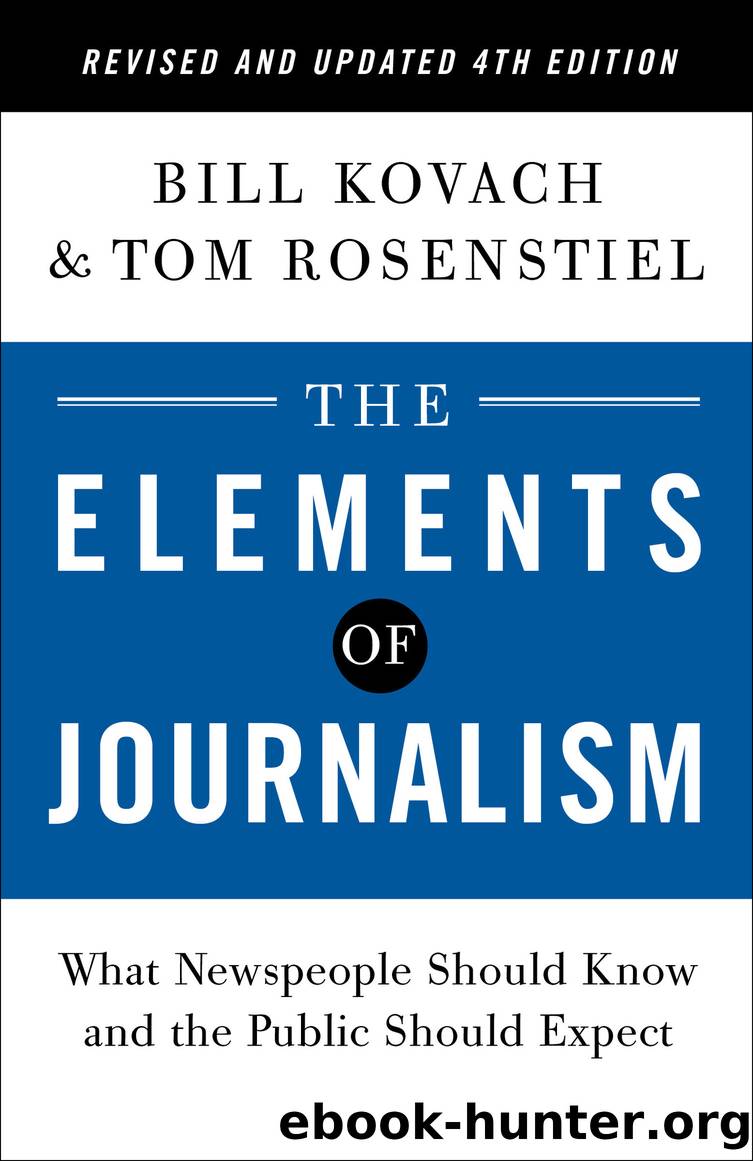The Elements of Journalism, Revised and Updated by Bill Kovach & Tom Rosenstiel

Author:Bill Kovach & Tom Rosenstiel [Kovach, Bill & Rosenstiel, Tom]
Language: eng
Format: epub
Publisher: Crown
Published: 2021-08-10T00:00:00+00:00
DIVERSITY AND JOURNALISTIC INDEPENDENCE
What does diversity in a newsroom mean? What role does personal background play in the choices someone makes about what is news and what is not, whom to interview, what voices to seek out, how to frame stories? It is one thing to say it matters. It is another to allow those forces to come into playâto create a newsroom where peopleâs backgrounds and their differences inform the news. A default culture begins to harden in a newsroom when everyone is supposed to think the same wayânot when their differences are encouraged to broaden how the news is created.
In what was clearly an acknowledgment that personal identity and experience influence journalistic decision-making, the news industry began to formally embrace the idea of diversity in the latter part of the twentieth century. The most public move in this direction came in 1978 when the American Society of Newspaper Editors formally stated that the number of people of color working at American newspapers should reflect the percentage in the general population.
More than forty years later, that effort can only be described as a failure. According to the best academic research, the American Journalist Project, headed by David H. Weaver, Lars Willnat, and G. Cleveland Wilhoit, in 1971 just 3.9 percent of people working in newsrooms across media were Black. By 2013 that number had barely budged, at 4.1 percent.25
Beneath those numbers was a more complex storyâhiring programs, mentorship programs, culture clashes, and talented people of color leaving newsrooms in frustration. There was also progress made and then regression. But as newsrooms shrank because of economic disruption, and the media landscape fragmented into more partisan outlets, the problem of newsrooms lacking class, race, ethnic, and cultural diversity only worsened.
And as efforts to make newsrooms more diverse along racial and ethnic lines failed, the question of political or ideological diversityâanother dimension of our human cultureâwas largely ignored. This failure, in turn, is now connected to another profound challenge facing news and democracyâthe breach of trust between journalists and the roughly half of the American population who consider themselves conservative.
American newsrooms do not just lean toward an older, white, and male default culture. Over the last two generations, they also have become increasingly liberalâlargely because conservative voices have departed. The same researchers who found no progress on racial diversity, Wilhoit, Willnat, and Weaver, found a retreat when it came to political identity. Over the last two generations, conservatives began to leave local newsrooms. In 1971, fully 26 percent of US journalists identified themselves as Republicans, 36 percent as Democrats, and 33 percent as independents. By 2013, only 7 percent of those working in newsrooms identified themselves as Republican, a drop of almost fourfold. The number of self-described Democrats had fallen slightly, to 28 percent. Independents had swelled to 50 percent. Asked differently, 39 percent in 2013 described themselves as âleaning left,â 44 percent as âmiddle of the road,â and only 13 percent as âleaning right.â26
The reasons why newsrooms became narrower
Download
This site does not store any files on its server. We only index and link to content provided by other sites. Please contact the content providers to delete copyright contents if any and email us, we'll remove relevant links or contents immediately.
The Negative Trait Thesaurus: A Writer's Guide to Character Flaws by Angela Ackerman Becca Puglisi(747)
A New Voyage Round the World by William Dampier(668)
Short Fiction by Gustave Flaubert(601)
The Positive Trait Thesaurus: A Writer's Guide to Character Attributes by Angela Ackerman Becca Puglisi(594)
Animation and Advertising by Unknown(580)
Writing Heroes and Villains (A Masterclass in Genre Fiction) by Jackson Dean Chase(555)
The Best American Magazine Writing 2020 by Sid Holt(547)
Instagram for Fiction Authors: How to Find Readers, Build Community, and Sell More Books by Sandvig Hanna R(541)
A Dictionary of Modern English Usage by H. W. Fowler;David Crystal;(515)
The Writing Revolution: A Guide to Advancing Thinking Through Writing in All Subjects and Grades by Judith C. Hochman & Natalie Wexler(509)
Write Your Own Script by A.L. Brooks(497)
How to Write a KILLER LinkedIn Profile... And 18 Mistakes to Avoid: Updated for 2019 (14th Edition) by Brenda Bernstein(475)
The Best American Travel Writing 2020 by Jason Wilson(468)
The Craft of Writing Science Fiction that Sells by Ben Bova(452)
News from Nowhere; or An Epoch of Rest by William Morris & William Morris(451)
Writer's Craft Power Pack 2: Five-Book Bundle for Authors by Rayne Hall(449)
Baudelaire and Photography by Raser Timothy;(449)
Instagram for Fiction Authors: How to Find Readers, Build Community, and Sell More Books by Hanna R. Sandvig(439)
5 Steps to a 5: Writing the AP English Essay 2021 by Barbara Murphy(428)
